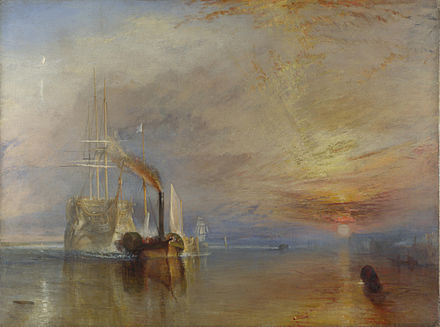While the movie Mr. Turner seems to have eluded many movie goers, it did not elude the critics who loved it. It was nominated for four Oscars, and Timothy Spall who plays Turner (who viewers will recognize as playing in the Harry Potter movies) won for Best Oscar at the Cannes Film Festival. It is now available on Blue Ray (and even on You Tube), and is well worth the time to watch, especially if you love art. Indeed, the beautiful scenario from Cornwall and Yorkshire etc. is all by itself worth watching.
J.M. W. Turner (1775-1851) was an English Romantic painter who was both prolific (20,000 items of his in the Tate gallery in London) and influential. If you take in enough of his famous ‘outdoor’ scenes, you will discover that long before the Impressionist movement in France, there were already painters who were masters of brilliant colors who had profound understanding of the way light changes things, more interested in portraying the essence of something rather than its exact physical replication on canvas. Turner was not only good with oils, he was excellent with watercolors as well. In due course he was recognized for a master painter and was inducted into the Royal Academy. And it wasn’t as if he didn’t have competition for he painted in the same period as Constable and Sir Joshua Reynolds.
The movie Mr. Turner focuses on the last 25 or so years of Turner’s life, the time period in which he was at his zenith as a painter. Several of the aspects of the movie require a little explication. First of all, his father, a barber by trade, acted as his assistant for some 30 years of his life. The portrayal of his relationship with his father is quite moving. Secondly, the movie does not tell us this, but Turner was never married. There was a woman, Sarah Danby, who claimed was the father of two daughters, but he never acknowledged them. What is true is that late in life he fell in love with Sophia Booth of Chelsa, indeed he mostly lived with her the last decades of his life when he was not traveling to do sketches and paint, and she was invaluable to him in various ways. This latter relationship is also well portrayed in the film. What is most affecting in the film is the depiction of some of the famous scenes that ended up in his paintings— Turner painting Nelson’s famous boat from the battle for Trafalgar, Turner’s painting of the steam train puffing down the tracks, Turner’s painting of a winter storm at sea, which in order to capture the essence of, he had himself tied to the mast of a ship in the midst of such a storm (producing bronchitis!). Then there are the famous paintings sail boats in distress on the sea. John Ruskin said that he aptly measured and depicted the moods of tempestuous nature. To give you a flavor of all this here is the painting of the Fighting Temaire
The acting in this film is superb from start to finish, and you get a very good sense of the importance of patronage (and purchasing) and the roles they played in most artist’s lives. Turner was in some respect exceptional in that he was a man of independent means in part due to his father’s successful business, thus it is not a surprise that we see at one point Turner declining the enormous sum of over 100,000 pounds offered by a rich art enthusiast on the grounds that
“this art belongs to the English people and belongs in a museum, not in a private collection”. ‘Billy’ Turner was not a religious man and indeed the film rightly depicts him as saying on his death bed “the sun is God”, a belief that the later Impressionists certainly seem to have shared.
The Blu Ray disk is especially worth having as it has lots of excellent bonuses including a study of Turner’s use of color, and the usual ‘making of’ commentary, as well as a deleted scene. If you love art, or someone you love does, this is a fine gift.











